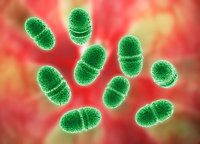Bacteria use biological weapons against enemies
American microbiologists discovered that bacteria could use biological weapons against their own congeners. Some of them contain bacteriophages in their DNA genome - the viruses that kill bacteria. When those "kamikazes" believe that there is not enough space around, they let the bacteriophages attack and kill their opponents.

Usually, when people talk about biological weapons, they primarily imply the use of malignant bacteria against an enemy. However, it is not only bacteria that cause diseases. As we know, there are also fungi and viruses. The first are rather capricious and are not capable of causing a quick epidemic (although they can be used to ruin food supplies at storage facilities, of course). As for viruses, they are quite difficult to cultivate because they can breed only in living cells. Therefore, most biological weapons are made from the cultures of bacteria that cause epidemic diseases.
Interestingly, it turns out that bacteria also have their own biological weapons. Humans can not use those weapons properly - it goes about viruses. These microorganisms can set bacteriophages (the viruses that infect only bacteria) on their competitors. Each bacterium carries the weapon inside before the moment when it releases the weapon to destroy its enemy.
Scientists from the Southwestern Medical Center, the University of Texas, Dallas (USA), were working with pathogenic bacterium Enterococcus faecalis, which account for one percent of all microorganisms in the human gut microflora. The scientists noticed that the strains of the bacterium could compete with each other. V583 strain would win battles most frequently. The representatives of the strain would destroy their rivals entirely. Most surprisingly, the latter could not resist the unknown weapon.
Biologists found it strange. E. faecalis are resistant to many antibiotics. However, all rivals of V583 strain proved to be powerless. Perhaps, the researchers suggested, the "aggressor" used something else instead of the bacterial antibiotic. To understand the situation, the researchers decided to study the genome of all strains.
The results showed that, first, their DNA was quite different. Secondly, the genome of V583 strain contained the so-called prophage. The term designates the DNA of the bacteriophage, which penetrates into the hereditary molecule of bacteria. It happens in a very interesting way. Most often, when bacteriophages infect a cell, they attach to specific receptors on its surface and then "inject" their DNA into the organism. The DNA immediately penetrates into the genome of the host. The injection of the virus genome triggers the complete transformation of cellular metabolism: the synthesis of bacterial DNA, RNA and proteins stops.
The hereditary molecule of bacteriophage does not waste any time. The molecule starts to copy itself and synthesize proteins for the virus, using the resources of the cell. Once all the "parts" are ready, young bacteriophages are built. In the end, they leave the host cell, tearing it apart.
The process can be different at times. The bacteriophage DNA molecule penetrates into the genome of bacteria and does not show any activity. That is the time when the prophage is formed. The host cell does not notice its presence: the cell eats, grows and multiplies, passing this "bomb" to its descendants. The "bomb" can "wake up" at any time and begin to create new phages. However, while the DNA is asleep, there is no danger posed to the cell.
However, sometimes for security reasons bacteria remove the DNA bacteriophage from their genome and place it in a special capsule - a plasmid. Afterwards, the plasmid can be transferred to congeners (bacteria often exchange them). At the same time, the plasmids with prophages are often passed to new generations.
Having studied the DNA of V583 strain, the researchers found two prophages instead of one there. One viral DNA allows the synthesis of its structural elements, and the other one produces the proteins of penetration that infect enemy's cells. When both prophages are activated, they produce a hybrid bacteriophage that kills all the competitors. Bacteria have not developed effective mechanisms of protection against these viruses (except for the above-described "taming" - turning into a prophage).
Scientists do not yet know how the activation of sleeping prophages takes place. Probably, bacteria have special proteins that can "wake up" the DNA of the virus. Only one thing is clear so far: when bacteriophages break free and get into the cells of other strains, they remain active and destroy them. But entering into the representatives of V583 strain, they become prophages again. It is quite possible that these microorganisms also have special means of protection, the nature of which is yet to be explored.
Of course, the cells from V583 strain die after the "awakening" of prophages. The formed viruses, as expected, burst through them as they exit. But their sacrifice is not in vain: competitors are eliminated. This behavior is similar to the situation when a soldier throws himself under a tank with a bunch of grenades in his hands: his death saves a whole military unit during an attack.
Apparently, the bacteria developed the ability to contain prophage in its genome in the process of evolution. It is possible that the use of phages is not a rare phenomenon among complex bacterial communities. Our benign intestinal inhabitants help people fight against pathogenic bacteria. It is possible that there is a biological weapon that plays an important role in the process.
Anton Evseyev
Pravda.Ru
Subscribe to Pravda.Ru Telegram channel, Facebook, RSS!


